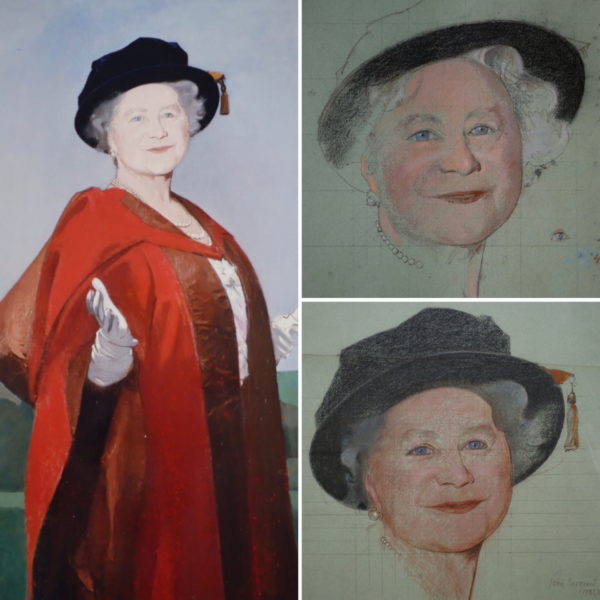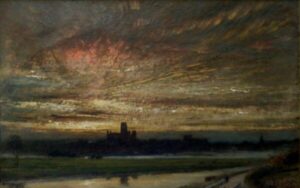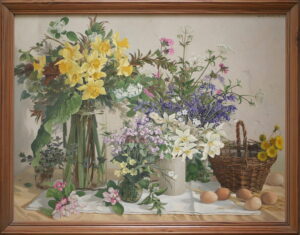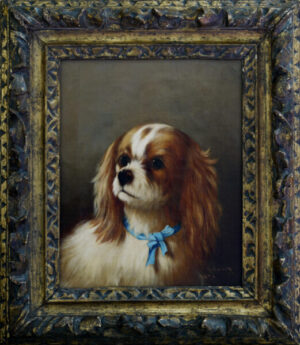Sergeant, John (1937-2010)
John Sergeant was born in the district of Woolwich, London, on 5th June 1937. He died aged 73 after a long illness at Builth Wells hospital, Mid-Wales, on 7th Jan 2010.
John lived a productive life pursuing his creative ambitions while achieving wide recognition with collectors and dealers for his paintings and drawings. The quizzical and eccentric nature of his character manifests itself in many of his compositions; occasionally also does his sense of humour. Over the years John had perfected his style and technique, mostly using charcoal estompé on Ingres paper. He also used coloured pastels and conté crayon, sometimes with small touches of Chinese white. John was a keen observer and loved to spend his spare time in antique shops and auctions where he would often find objects to draw. With him out on a walk in a churchyard one day he found lying on the ground a few small shards of an old tombstone with traces of old lettering, “excellent material to include in a drawing”, he announced, but unfortunately his cancer had weakened his resolve and sadly the drawing never came to fruition.
John was keenly interested in other artists past and present and collected works by artists he admired, some of whom he had known or had some association with, including G. L. Brockhurst, and A. G. Jones. His tastes were varied and he would also look for primitive or Naïve paintings, especially if the picture amused him. John kept an extensive library of art reference books, J. A. D. Ingres, H. Fuseli, and A. Menzel are some of the artists whose work had an influence. E. Bawden, G. L. Brockhurst, and E. Ravilious are a few of his more modern favourites.
During the war, his early life nearly ended just as soon as it had begun. One evening while he was asleep in bed a bomb fell through the roof of his family home narrowly missing his bedroom, the bomb failed to explode but the house caught fire, fortunately, John’s father (Edward) quickly managed to whisk him from his bed to safety. It must have been a very traumatic time but not one they had not experienced before. John had an elder brother (Harry) who had tragically died in an accident at the age of 16. This unfortunate incident happened while on holiday swimming in the public baths at Portsmouth. John, aged 9, was present at the time of his death.
After escaping the ruins of war the family moved to Water Lane, Ospringe, at Faversham in Kent. John was educated at the local Grammar School where in the summer of 1953 he passed his exam in art, albeit with no particular distinction. However, in January 1954 he was accepted into Canterbury College of Art to start his first term. Evidence from correspondence between the college’s principal, A. Moody and John’s parents would suggest that his first year was average, however, his work soon improved and in his second year took a course in Advertisement Design and was awarded a 1st with distinction in Drawing, and a further two 1st’s for Design and History and Methods. In his final year, he took The Examination for the National Diploma in Design and passed with first-class honours. The college’s principal A. Moody wrote to John congratulating him on his distinguished success.
While John was at Canterbury it was pointed out in a report that his strengths lay in his drawing and painting, but like many artists, a vision for the future and making a living was of chief concern which may have been the reason why he channelled his energies into illustration. He first applied for an entrance examination to The Royal College of Art in South Kensington as an Illustrator but was rejected; however, they had been prepared to examine him as a candidate for the Department of Engraving. This must have been a blow and although he did apply and was accepted to sit the examination he was unable to enter the College, instead, John had been conscripted into the RAF for National Service. He started in 1957 and was stationed at Duxford where he served in E.P.A.S. (Equipment, Pay and Accounting Section). His time with the RAF ended in 1959.
During his time at Canterbury John had met the acclaimed artist John Ward. Ward was 20 years his senior and was already established in his career but the meeting led to a successful and lasting friendship. Through Ward, John also met the artist Jehan Daly (1918-2001) who also became one of his long-established friends. In 1959, with Ward’s encouragement, John entered the Royal Academy Schools, wherein 1962, his final year; he won the drawing prize and married a fellow student, Carolyn Cann. Carolyn was equally successful in her career and was esteemed for her carefully arranged botanical subjects. John and Carolyn lived in Faversham and other locations in the county before making their final move to Wales in 1983.
John pursued his career to teach at Canterbury College of Art, and the Art Schools of Dover and Folkestone. In 1981 while visiting London he was greatly inspired by the exhibition of Interiors held by the renowned art dealer, Sir Jack Baer, at Hazlitt Gooden and Fox. Together they formed a close friendship and with Sir Jack’s help John went on to secure commissions to make a series of room portraits, visiting Castle Coole, Stowell Park, and Deene Park. The drawings he made of Erddig were acquired by the National Trust. Sir Jack Baer was a great proponent of John and Carolyn’s work, frequently holding exhibitions for them at the Hazlitt gallery.
Several one-man exhibitions were held at the Mass Gallery in Clifford Street; in 1986 and 1988, and a third in 1991, culminating in 1992 with a show of works done in Prague, where he accompanied the Prince of Wales on an official visit. HRH the Prince of Wales first noticed John’s work at the National Trust exhibition, The Long Perspective, at Agnews in 1987, in which the artist showed drawings and watercolours of Errdig House in Wales. The Prince asked him to do some drawings for his book, A Vision of Britain, in 1989 and invited him to stay at Sandringham the following year to make a record of several large barns on the estate. John accompanied the Prince and Princess of Wales to Prague from 6 to 10 May 1991, the focus of the trip was architectural heritage. In 1994 at the Hazlitt Gallery John’s work was shown in “Three Contemporary Masters” alongside that of John Ward and Jehan Daly.
Several exhibitions followed:
John Sergeant Drawings: Hazlitt Gooden & Fox, 1996
John Sergeant Recent Drawings: Hazlitt Gooden & Fox, 2000
John Sergeant Recent Drawings: Sir Jack Baer & Co in association with The Fine Art Society, 2002
John Sergeant Recent Drawings: Sir Jack Baer & Co in association with Katrin Bellinger at Colnaghi, 2006
John has also exhibited at the Royal Academy, the Royal Society of Portrait Painters, the Victoria & Albert Museum, the New Grafton Gallery, the Trafford Gallery, the National Museum and Gallery of Wales, Cardiff, and the Royal Library, Windsor.
After John’s death, a number of his drawings including a self-portrait were donated to the Fitzwilliam Museum, Cambridge. The museum had previously acquired a drawing, Collars, in 1994.
Living within a few miles of their home in Wales my wife and I had the pleasure of knowing John and Carolyn. We became good friends and were surprised to learn that we had much in common. As a child in the 60s, I also lived in Water Lane, Ospringe, and I have no doubt that John may have visited my parent’s Antique shop in Faversham during the 70s. Our tastes in art were very similar and on his death, John kindly bequeathed to me 'Gloves and Necklace', from his 1992 exhibition. The drawing (named by Sir Jack) has an interesting story of its own.
Father;- Alfred Edward Sergeant, (b. Huntingdonshire, 21 Feb 1895 – d. Kent, June 1985.)
Mother;- Elsie Anne Herbert (b. Woolwich, Kent, 8 Sep 1896 – d. Surrey, Feb 1979.)
Brother;- Harry Sergeant (b. Woolwich, Kent, 1930 – d. age 16, Plymouth, Devon, 15 June 1946.)
Married 1962, Sittingbourne, Kent;- Alison Margaret Carolyn Cann, (b. Wycombe, Buckinghamshire, (26th Sep 1937 - d. Herefordshire, 25th Jan 2018.)
John and Carolyn have two surviving sons:- Edward and Ben.



